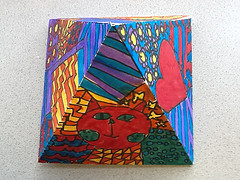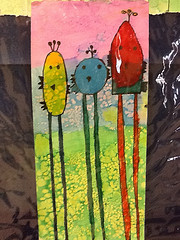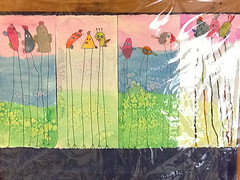The final kiln load, graded and returned to 4th and 5th grade students. As I mentioned before, 4th graders created animals of choice by breaking everything down into shapes to form their creatures. Fifth grades students take it a step further and turn their animals into clay whistles. I was especially pleased by the creativity of both groups this year. Some pieces are realistic, some whimsical and all personally creative. I had a few favorites that it was hard to see walk out of the classroom and teasingly told students that I had to keep them! Thankfully, all were photographed so I can retain the images to share with students of future classes. Now, I share them with all of you.
Saturday, April 27, 2013
Monday, April 22, 2013
Sharing some Romero Britto Pyramids

I posted earlier about a series of projects for 4th grade that focused on shapes review for Math MCAS. A few of the 4th graders have now finish the 2nd shape, a pyramid with a Romero Britto theme. The focus was to make one large object on each side of the pyramid and then break the background up with a variety of patterns that would flow from one side of the pyramid to the next. I think they are doing a great job with the assignment.
The next shape will be a cylinder in the style of Andy Warhol. Thinking soup can anyone?
First Grade Wacky Birds

 I found this project on pinterest that had originated from the blog Small Hands Big Art and decided I had to use it as an extension to the Wacky Birds Cooperative Murals. This way students would have something they could take home since the murals are a group project. We pulled out those terrific Wacky Bird handouts from Expressive Monkey and each student designed their own birds. They had used watercolors and kosher salt to create the background the week before. The idea was to make their birds with really looongggg legs. I pulled out some watercolor oil craypas to color the birds. This was the first time we had worked with these and the kids were really excited for a new medium.
I found this project on pinterest that had originated from the blog Small Hands Big Art and decided I had to use it as an extension to the Wacky Birds Cooperative Murals. This way students would have something they could take home since the murals are a group project. We pulled out those terrific Wacky Bird handouts from Expressive Monkey and each student designed their own birds. They had used watercolors and kosher salt to create the background the week before. The idea was to make their birds with really looongggg legs. I pulled out some watercolor oil craypas to color the birds. This was the first time we had worked with these and the kids were really excited for a new medium.Friday, April 19, 2013
Discovering Horace Pippin and the National Gallery of Art
I recently purchased a book about Horace Pippin by Jen Bryant. The book is A Splash of Red. It's a nice little biographical book chronicling his discovery of a love for creating art and how it carried through his life. I was not terribly familiar with Pippin so started googling for more information. I discovered a wonderful website, NGA Classroom. I found a terrific biography, photos of his work as well as lesson and connections. I've added a permanent link on the right side of this blog. RIght now I think I will approach this lesson with a focus on folk art and reading a picture. I am eager to introduce students to a new artist as well.

Labels:
folk art,
literacy in art
Thursday, April 18, 2013
Books from the bookshelf - final installment (for now!)
Here are the last ten books from my bookshelf along with a brief overview of how I use them in the Art room. As I've mention in previous post, I most often use these books with my Kindergarten classes. The books I commonly use with older students are more artist specific such as the Getting to Know the Worlds Greatest Artist series by Mike Venezia. I have included a few older student books in this list as well.
 Action Jackson by Jan Greenberg is one of older student books. This is a biographical story that I use to introduce the artist and his life to students. Elementary students love the idea of painting like Jackson Pollock, just be prepared and organized so splatter painting doesn't go wild!
Action Jackson by Jan Greenberg is one of older student books. This is a biographical story that I use to introduce the artist and his life to students. Elementary students love the idea of painting like Jackson Pollock, just be prepared and organized so splatter painting doesn't go wild!
 How is a budding young artist suppose to cope when Mom takes away her crayons? This is the story line in the book A Day with no Crayons by Elizabeth Rusch. This is a cute tale that I do use with younger students. I do not incorporate a specific lesson plan to this book but use it more to stress creativity and also the proper use of materials. It's a cute little book.
How is a budding young artist suppose to cope when Mom takes away her crayons? This is the story line in the book A Day with no Crayons by Elizabeth Rusch. This is a cute tale that I do use with younger students. I do not incorporate a specific lesson plan to this book but use it more to stress creativity and also the proper use of materials. It's a cute little book.

 Kathryn Otoshi has written a poignant little tale about difference and importance in her book, One. As the colors argue about their importance, one comes into the picture and helps everyone to see that they all count. It's a great book to use if you are having difficulty with name calling or students not getting along. I try to squeeze a few books into my library on this subject. Teaching social skills is so important in school and test focus leaves little time to help youngster work on those skills. Books like this can create an opportunity for dialogue, even in the Art room. It could be used to introduce a cooperative project or to just set the proper mood and expectations for the Art room.
Kathryn Otoshi has written a poignant little tale about difference and importance in her book, One. As the colors argue about their importance, one comes into the picture and helps everyone to see that they all count. It's a great book to use if you are having difficulty with name calling or students not getting along. I try to squeeze a few books into my library on this subject. Teaching social skills is so important in school and test focus leaves little time to help youngster work on those skills. Books like this can create an opportunity for dialogue, even in the Art room. It could be used to introduce a cooperative project or to just set the proper mood and expectations for the Art room.

My sister purchased the next two books for me late in the school year last year. I read them both to students and the discussion led to creative imagination and the empowerment of creativity. They are great books and can be found free on several book sites to download to you computer. Antoinette Portis is the author of Not A Box and Not a Stick.
 Another creative inspiration book is Ish by Peter Reynolds. The story line is that Art doesn't have to be perfectly realistic and can be treasured for what it is, regardless how "ish". There is also a wonderful video to accompany this book. Many of Peter Reynolds books can be found on those free download sites for classroom use as well as on youtube.
Another creative inspiration book is Ish by Peter Reynolds. The story line is that Art doesn't have to be perfectly realistic and can be treasured for what it is, regardless how "ish". There is also a wonderful video to accompany this book. Many of Peter Reynolds books can be found on those free download sites for classroom use as well as on youtube.


 I generally introduce 2nd grade students to Georgia O'Keefe as a spring lesson. I have done this lesson in a few different ways over the years but I think my favorite lesson was one inspired by an overabundant supply of felt squares. Students chose a colored square and oil pastels are used to create an O'Keefe flower large enough to fill the 12" x 12" square. The book I use to share her biography is by Jen Bryant and titled Georgia's Bones. A friend has a real skull that she uses and has student's draw a skull for this lesson. I also use the book Through Georgia's Eyes by Julie Paschkis. A third O'Keefe title is Georgia O'Keefe: The Artist in the Desert - Adventures in Art from Prestel Press. This book includes wonderful photographs of the artist along with some great prints of her work. It is more biographical in nature for her later years of life. Prestel Press
I generally introduce 2nd grade students to Georgia O'Keefe as a spring lesson. I have done this lesson in a few different ways over the years but I think my favorite lesson was one inspired by an overabundant supply of felt squares. Students chose a colored square and oil pastels are used to create an O'Keefe flower large enough to fill the 12" x 12" square. The book I use to share her biography is by Jen Bryant and titled Georgia's Bones. A friend has a real skull that she uses and has student's draw a skull for this lesson. I also use the book Through Georgia's Eyes by Julie Paschkis. A third O'Keefe title is Georgia O'Keefe: The Artist in the Desert - Adventures in Art from Prestel Press. This book includes wonderful photographs of the artist along with some great prints of her work. It is more biographical in nature for her later years of life. Prestel Press
 Lastly, and by no means last in importance, is Harold and the Purple Crayon by Crockett Johnson. This book has withstood the test of time and still remains relevant and entertaining for young students. Scholastic has a wonder video of the story and numerous online resources are available for downloading the book to your computer. I like using Harold with Kindergarten students anytime during the year but it is especially good when introducing line and how line makes shape.
Lastly, and by no means last in importance, is Harold and the Purple Crayon by Crockett Johnson. This book has withstood the test of time and still remains relevant and entertaining for young students. Scholastic has a wonder video of the story and numerous online resources are available for downloading the book to your computer. I like using Harold with Kindergarten students anytime during the year but it is especially good when introducing line and how line makes shape.
The following is a list of newly acquired books that I have not incorporated into lesson plans as of yet but am currently working on.
The Art of Silliness by Carla Sonheim
A Splash of Red the life and art of Horace Pippin by Jen Bryant
Colorful Dreamer the Story of Artist Henri Matisse by Marjorie Blain Parker
Sky Color by Peter Reynolds
Magritte's Marvelous Hat by D.B. Johnson
Andrew Drew and Drew by Barney Saltzberg
Anholt's Artist Activity Book by Laurence Anholt
One of my goals for the remainder of Spring Break is to create lessons using at least two of these books. Wish me luck!!!
My sister purchased the next two books for me late in the school year last year. I read them both to students and the discussion led to creative imagination and the empowerment of creativity. They are great books and can be found free on several book sites to download to you computer. Antoinette Portis is the author of Not A Box and Not a Stick.
The following is a list of newly acquired books that I have not incorporated into lesson plans as of yet but am currently working on.
The Art of Silliness by Carla Sonheim
A Splash of Red the life and art of Horace Pippin by Jen Bryant
Colorful Dreamer the Story of Artist Henri Matisse by Marjorie Blain Parker
Sky Color by Peter Reynolds
Magritte's Marvelous Hat by D.B. Johnson
Andrew Drew and Drew by Barney Saltzberg
Anholt's Artist Activity Book by Laurence Anholt
One of my goals for the remainder of Spring Break is to create lessons using at least two of these books. Wish me luck!!!
Subscribe to:
Comments (Atom)

















